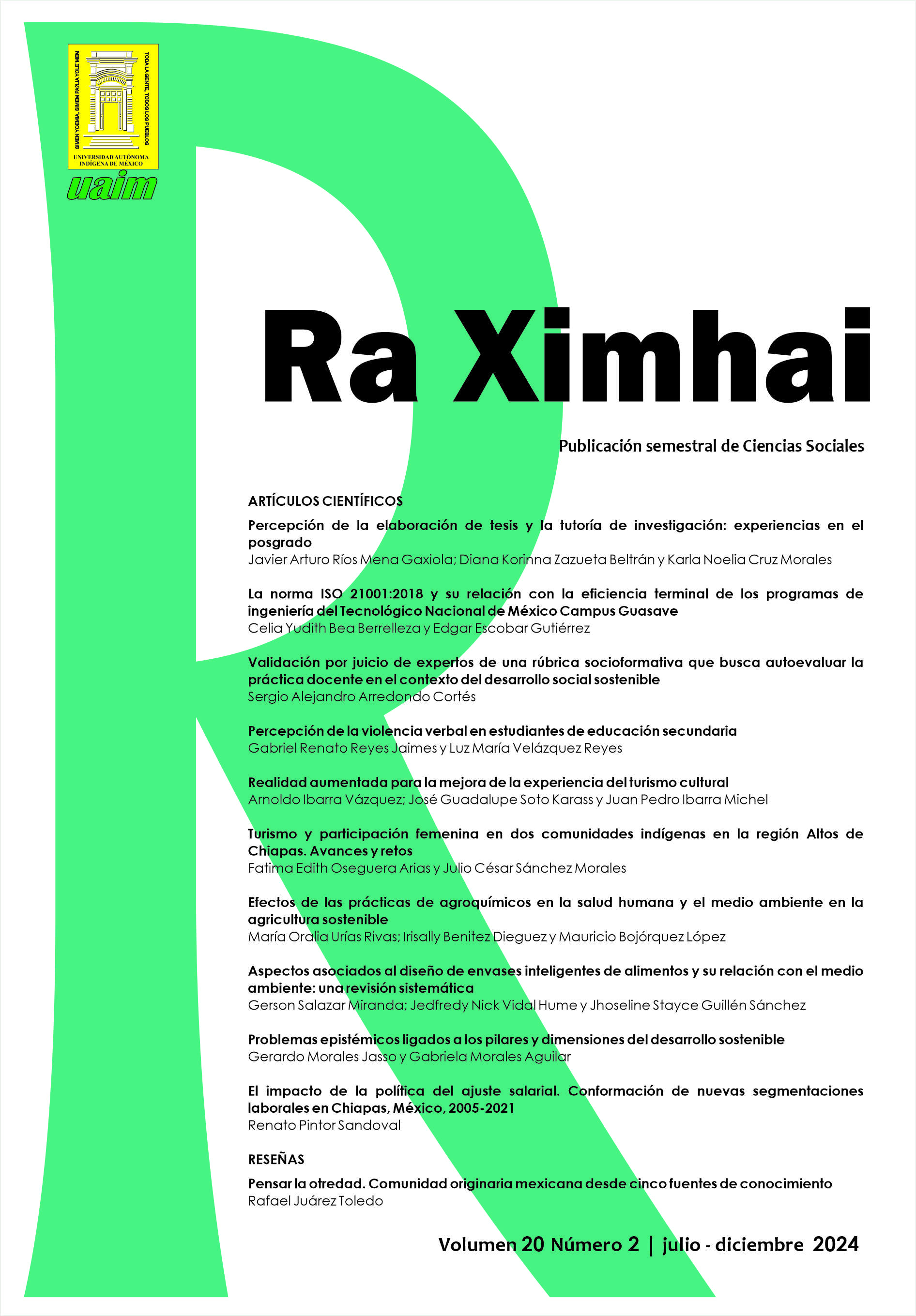Augmented reality to enchance cultural tourism experience
DOI:
https://doi.org/10.35197/rx.20.02.2024.05.aiKeywords:
digitalization, augmented reality, cultural tourism, technological innovation, self-guided tourismAbstract
Digital innovation is advancing exponentially, with new technologies being developed and adapted to different industrial sectors, such as medical, educational, sports, video games, and tourism. This is the case of Augmented Reality (AR), a technology based on the interaction between the digital world and the real world, where people can perceive more than what the real world provides. AR offers tourism a new opportunity for interaction with destinations, cultural knowledge, archaeological infrastructure, and hobbies, all accessible with just a touch through smartphones. This research aims to evaluate the feasibility of implementing AR in cultural tourism areas, focusing part of its analysis on the use of AR in heritage and archaeological sites to conceptualize trends in cultural tourism through mobile applications. A descriptive and comparative analysis of the literature was conducted to understand the possibility es of AR and its importance in cultural tourism, obtaining notable, applicable, and desirable information in various tourist areas. The use of AR in archaeological, museum, and cultural areas such as "Pueblos Mágicos" in Mexico is proposed to promote tourism digitalization, as well as the creation of personalized routes and activities in conjunction with Artificial Intelligence (AI) for the development of cultural tourism.
Downloads
References
Aczel, B., Kovacs, M., Van der lipe, T., & Szászi, B. (2021). Researchers working from home: Benefits and challenges. PLOS ONE, 1-13. https://doi.org/10.1371/journal.pone.0249127
Aguirre, B. C. (2015). Augmented Reality applied in Tourism Mobile Applications. 2015 Second International Conference on eDemocracy & eGovernment (ICEDEG) (págs. 120-125). Quito, Ecuador: 2015 Second International Conference on eDemocracy & eGovernment (ICEDEG). https://doi.org/10.1109/ICEDEG.2015.7114484
Baregheh, A., Sambrook, S., & Rowley, J. (2009). Towards a Multidisciplinary Definition of Innovation. Management Decision, 47(8), 1323-1339. https://doi.org/10.1108/00251740910984578
Cibilic, I., Posloncec, P. v., & Tominic, K. (2021). Implementing Augmented reality in Tourism. International Cartographic Association, 1-5. https://doi.org/10.5194/ica-proc-4-21-2021
CODESIN. (2022). Radiografía del Turismo en Sinaloa durante el año 2022. Culiacán. Panorama estatal del turismo en Sinaloa: https://codesin.mx/file/9/139_PANORAMA%20ESTATAL%20DE%20TURISMO%20EN%20SINALOA%20-%202023.pdf_1700077596.pdf
Cranmer, E. E., Tom, D. M., & Fountoulaki, P. (2020). Exploring the value of augmented reality for tourism. Tourism Management Perspectives, 1-9. https://doi.org/10.1016/j.tmp.2020.100672
Dai-In, D. H., Dieck, T., & Jung, T. (2019). Augmented Reality Smart Glasses (ARSG) visitor adoption in cultural tourism. Leisure Studies, 1-14. https://doi.org/10.1080/02614367.2019.1604790
Dai-In, H., Jung, T., & Gibson, A. (2013). Dublin AR: Implementing Augmented Reality in Tourism. Information and Communication Technologies in Tourism 2014 (págs. 511-523). Springer. https://doi.org/10.1007/978-3-319-03973-2_37
Forbes Staff. (13 de 11 de 2023). Crean en Guadalajara la primera ruta urbana de realidad aumentada en el mundo. Forbes México: https://www.forbes.com.mx/crean-en-guadalajara-la-primera-ruta-urbana-de-realidad-aumentada-en-el-mundo/
Garay, C. (2015). Desarrollo de un prototipo de mini juego informativo tipo geocaching con realidad aumentada. Bogotá. https://repository.unimilitar.edu.co/bitstream/handle/10654/15317/GarayCortesJuanDavid2016.pdf?sequence=1&isAllowed=y
Gudadhe, M., Bhanse, D., Dhengre, B., Patle, T., Mange, K., & Patil, V. (2021). Augmented Reality in Tourism: An Innovative Way to Attract Tourists. International Journal of Innovations in Engineering and Science, 1-4. https://doi.org/10.46335/IJIES.2021.6.6.1
Hernández, G. (26 de 10 de 2023). Google Maps se actualiza con realidad aumentada en México: resultados temáticos e información para autos eléctricos . Xataka: https://www.xataka.com.mx/aplicaciones/google-maps-se-actualiza-realidad-aumentada-mexico-resultados-tematicos-e-informacion-para-autos-electricos#comments
Jingen, L. L., & Elliot, S. (2020). A systematic review of augmented reality tourism research: What is now and what is next? Tourism and Hospitality Research, 1-16. https://doi.org/10.1177/1467358420941913
Khlaif, G. M., Khlaif, G. N., Ayoub, K. M., Abu-ain, W. A., & Kasim, A. M. (2021). Intention to Use Mobile Augmented Reality in the Tourism Sector. Computer Systems Science & Engineering, 187-202. https://doi.org/10.32604/csse.2021.014902
Kounavis, C. D., Kasimati, A. E., & Zamani, E. D. (2012). Enhancing the Tourism Experience through Mobile Augmented Reality: Challenges and Prospects. International journal of Engineering Business Management, 1-6. https://doi.org/10.5772/51644
OCDE. (2005). Manual de Oslo. Grupo Tragsa.
Pencarelli, T. (2020). The digital revolution in the travel and tourism industry. Information Technology & Tourism, 455-476. https://doi.org/https://doi.org/10.1007/s40558-019-00160-3
Sanz, G. (2021). Las redes sociales más allá de la socialización y la comunicación. En G. Sanz, Estratégias lingüisticas para la sociedad multilenguaje (págs. 117-128). Barcelona: Octaedro. https://doi.org/10.36006/16333
Shevchenko, E., & Kazmina, L. (2021). Digitization and technological innovations in tourism of the Rostov region (the case of mobile applications for smartphones). E3S Web of Conferences 273 (págs. 1-9). Rostov: EDP Sciences. https://doi.org/10.1051/e3sconf/202127309019
Van Nuenen, T., & Scarles, C. (2021). Advancements in technology and digital media in tourism. Tourist Studies, 1-14. https://doi.org/10.1177/1468797621990410
Varona, A. D. (2017). Streaming: La Sociedad Broadcast. En A. C. Obando, & R. J. Hernández, La metafísica de Internet: Nuevas formas de relato en la cultura web (págs. 142-165). Universidad de San Jorge. https://www.researchgate.net/publication/323960562_Streaming_La_sociedad_Broadcast
Vlahkis, V., Karigiannis, J., Tsotros, M., & Gounaris, M. (2001). ARCHEOGUIDE: first results of an augmented reality, mobile computing system in cultural heritage sites. Proceedings of the 2001 Conference on Virtual Reality, Archeology, and Cultural Heritage. Glyfada. https://doi.org/10.1145/584993.585015
Ying, Y. C., Jung, T., Tom, D. M., & Younghee, L. M. (2021). Mobile Augmented Reality Heritage Applications: Meeting the Needs of Heritage Tourists. Sustainability, 1-18. https://doi.org/10.3390/su13052523
Downloads
Published
How to Cite
Issue
Section
License

This work is licensed under a Creative Commons Attribution-NonCommercial 4.0 International License.
Usted es libre de:
- Compartir — copiar y redistribuir el material en cualquier medio o formato
- Adaptar — remezclar, transformar y construir a partir del material
- La licenciante no puede revocar estas libertades en tanto usted siga los términos de la licencia
Bajo los siguientes términos:
- Atribución — Usted debe dar crédito de manera adecuada , brindar un enlace a la licencia, e indicar si se han realizado cambios . Puede hacerlo en cualquier forma razonable, pero no de forma tal que sugiera que usted o su uso tienen el apoyo de la licenciante.
- NoComercial — Usted no puede hacer uso del material con propósitos comerciales .
- No hay restricciones adicionales — No puede aplicar términos legales ni medidas tecnológicas que restrinjan legalmente a otras a hacer cualquier uso permitido por la licencia.








